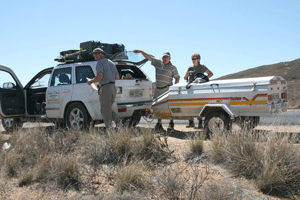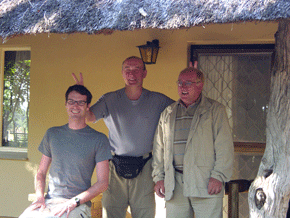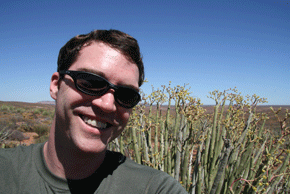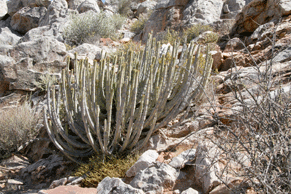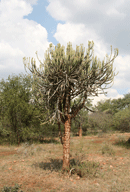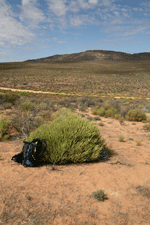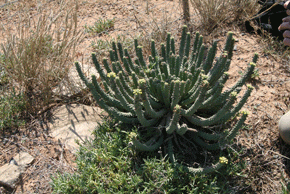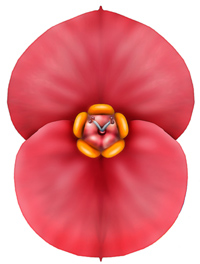
|
Euphorbia - Fieldwork Activities | ||||||||||||||
Home Project Participants About Euphorbia Fieldwork News Data Portal Interactive Key Links Contact Us | South Africa, 15 March - 19 April 2008 Participants: Paul Berry, Jeff Morawetz, Rolf Becker, Alma Moller, Robert Archer, Peter Bruyns. Trip account by Jeff Morawetz. Paul and I departed for South Africa on 15 March 2008. We arrived late the following night at the Cape Town International Airport, and were met by our collaborators and trip-planners Rolf Becker and Alma Moller. They took us to a nearby hotel, and we discussed our general strategy and the itinerary that they had prepared for us.
Our first stop was in Clanwilliam, in the vicinity of the scenic Cederberg Montains in the Western Cape Province. It was here that Paul and I were introduced to the Euphorbia mauritanica, E. burmannii, and the E. rhombifolia complex. Of the more unique species we collected were E. loricata, E. filiflora, and E. schoenlandii. It was also along this part of the trip that we were first introduced to the members of the E. caput-medusae complex. Carrying on from Clan William we worked our way into the Northern Cape Province, stopping in Van Rhynsdorp, Doringbaai, Sprinkbok and Port Nolloth on our way to the Richtersveld Transfrontier National Park, bordering Namibia. The Richtersveld is a rugged, mountainous desert region in South Africa's arid Namaqualand. During this portion of the trip I was introduced to my all time favorite Euphorbia species, E. dregeana. We also found the shrubby E. guerichiana, and the diminuitive E. einensis. Other featured species were E. hottentota, E. ephedroides, E. gariepina, and E. herrei.
From the Richtersveld we headed to Rolf and Alma's home base in Polokwane, Limpopo Province. On the way we stopped in Namaqua National Park and Kathu. Namaqua National Park yielded E. restituta, E. spinea and E. gummifera. Once in Polokwane we collected around Sekhukhune District, a much less arid area than the Richtersveld, yet full of succulent spine-shield species, among others. It was here that we collected the endangered (known from only two populations) E. clivicola. We also collected E. groenewaldii from two populations, in addition to a number of larger spine-shield species such as: E. barnardii, E. grandialata, E. enormis, E. schinzii, E. ingens, E. cooperi and E. excelsa. We also got to visit the herbarium at the University of Limpopo (UNIN) and Alma showed us all the hard work she's been doing to catalogue the collections of Larry Leach. She's made amazing progress, already having completed the pickled collections before our visit. She and Rolf have begun scanning the Leach papers, fieldnotes and photographs that are archived at UNIN. After this we all packed our things to head down to see Robert Archer at the National Herbarium in Pretoria (PRE). We spent our time in the herbarium looking through the collections. So we got some locality data for several succulent species, and spent some time walking through the garden and greenhouses with Robert. Robert also took us to Gariep Nursery, which has a lovely collection of Euphorbia species as well as other succulents.
It was at this point that Paul and I said our goodbyes to our dear friends and traveling companions Rolf and Alma, and also bid Robert farewell, and we set off on our own for Cape Town, via the Eastern Cape Province. Our first stop was in the quaint Karoo town of Cradock, and from there we headed to Grahamstown. On our way to Grahamstown we collected E. tetragona, E. pentagona and E. x bothae. Paul and I met with Tony Dold at the Selmar Schonland Herbarium (GRA) at the Albany Museum of Rhodes University. Tony pointed us to a population of E. polygona right behind the museum. He also drew us a map to find a population of E. bupleurifolia, but unfortunately we were unable to locate any individuals at that location. Despite this setback, we did collect E. inermis, E. triangularis, E. enopla, and E. caerulescens, among other more common species previously mentioned. From Grahamstown we headed to Cape Town, with a stop at De Rust. We were hoping to track down noted euphorbiologist Gerhard Marx, but it was not meant to be. We did however collect several Euphorbia species along the way, such as: E. ferox, E. burmannii, E. indecora, E. lignosa, and E. heptagona. Once back in Cape Town we had some time to see some sights, notably Table Mountain, which stood just in our backyard. We enjoyed a lovely stay at the Nedbank Lodge on the grounds of the Kirstenbosch Botanical Garden. While we unfortunately missed Dee Snijman and Koos Roux (they had just left for a field trip in the Eastern Cape!), we were able to catch up with John Manning, Edwina Marinus and Suzette Foster at the Compton Herbarium (NBG). We took a quick drive up to the Karoo Botanic Garden in Worcester to see the living collections of Leach that are still housed there as well. It was during our time in Cape Town that we were able to arrange a meeting with Peter Bruyns, and he not only invited us to his home to see his Euphorbia living collection, but also took us to the greenhouses at the University of Cape Town where a number of other species are in cultivation. Further, he took us on a walk up the hill behind UCT to collect two herbaceous Euphorbia species, E. genistoides and E. helioscopia. Our fieldwork was then complete! We spent some time going through the collections at the Bolus Herbarium (BOL) at the University of Cape Town, thanks to the kindness of Keeper Terry Hedderson and Aizoaceae expert Cornelia Klak. |
||||||||||||||
|
© PBI Euphorbia Project | |||||||||||||||
